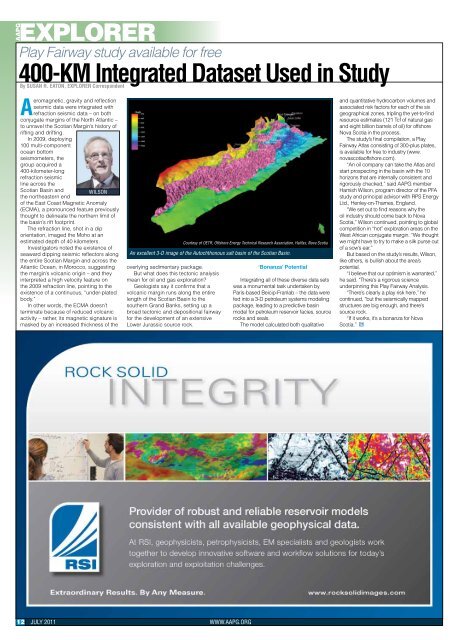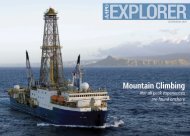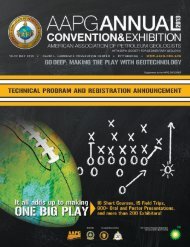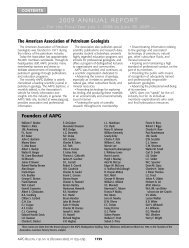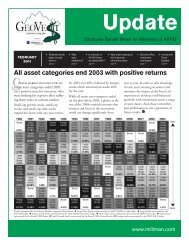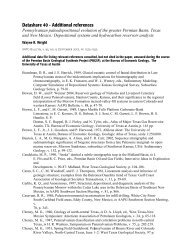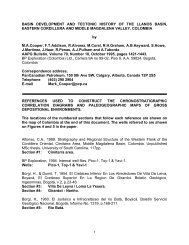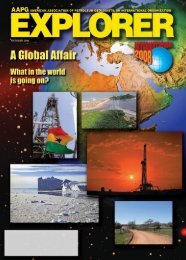AAPG Explorer - American Association of Petroleum Geologists
AAPG Explorer - American Association of Petroleum Geologists
AAPG Explorer - American Association of Petroleum Geologists
Create successful ePaper yourself
Turn your PDF publications into a flip-book with our unique Google optimized e-Paper software.
<strong>AAPG</strong><br />
EXPLORER<br />
Play Fairway study available for free<br />
400-KM Integrated Dataset Used in Study<br />
By SUSAN R. EATON, EXPLORER Correspondent<br />
Aeromagnetic, gravity and reflection<br />
seismic data were integrated with<br />
refraction seismic data – on both<br />
conjugate margins <strong>of</strong> the North Atlantic –<br />
to unravel the Scotian Margin’s history <strong>of</strong><br />
rifting and drifting.<br />
In 2009, deploying<br />
100 multi-component<br />
ocean bottom<br />
seismometers, the<br />
group acquired a<br />
400-kilometer-long<br />
refraction seismic<br />
line across the<br />
Scotian Basin and<br />
the northeastern end<br />
WILSON<br />
<strong>of</strong> the East Coast Magnetic Anomaly<br />
(ECMA), a pronounced feature previously<br />
thought to delineate the northern limit <strong>of</strong><br />
the basin’s rift footprint.<br />
The refraction line, shot in a dip<br />
orientation, imaged the Moho at an<br />
estimated depth <strong>of</strong> 40 kilometers.<br />
Investigators noted the existence <strong>of</strong><br />
seaward dipping seismic reflectors along<br />
the entire Scotian Margin and across the<br />
Atlantic Ocean, in Morocco, suggesting<br />
the margin’s volcanic origin – and they<br />
interpreted a high velocity feature on<br />
the 2009 refraction line, pointing to the<br />
existence <strong>of</strong> a continuous, “under-plated<br />
body.”<br />
In other words, the ECMA doesn’t<br />
terminate because <strong>of</strong> reduced volcanic<br />
activity – rather, its magnetic signature is<br />
masked by an increased thickness <strong>of</strong> the<br />
overlying sedimentary package.<br />
But what does this tectonic analysis<br />
mean for oil and gas exploration?<br />
<strong>Geologists</strong> say it confirms that a<br />
volcanic margin runs along the entire<br />
length <strong>of</strong> the Scotian Basin to the<br />
southern Grand Banks, setting up a<br />
broad tectonic and depositional fairway<br />
for the development <strong>of</strong> an extensive<br />
Lower Jurassic source rock.<br />
12 JULY 2011 WWW.<strong>AAPG</strong>.ORG<br />
Courtesy <strong>of</strong> OETR, Offshore Energy Technical Research <strong>Association</strong>, Halifax, Nova Scotia<br />
An excellent 3-D image <strong>of</strong> the Autochthonous salt basin <strong>of</strong> the Scotian Basin.<br />
‘Bonanza’ Potential<br />
Integrating all <strong>of</strong> these diverse data sets<br />
was a monumental task undertaken by<br />
Paris-based Beicip-Franlab – the data were<br />
fed into a 3-D petroleum systems modeling<br />
package, leading to a predictive basin<br />
model for petroleum reservoir facies, source<br />
rocks and seals.<br />
The model calculated both qualitative<br />
and quantitative hydrocarbon volumes and<br />
associated risk factors for each <strong>of</strong> the six<br />
geographical zones, tripling the yet-to-find<br />
resource estimates (121 Tcf <strong>of</strong> natural gas<br />
and eight billion barrels <strong>of</strong> oil) for <strong>of</strong>fshore<br />
Nova Scotia in the process.<br />
The study’s final compilation, a Play<br />
Fairway Atlas consisting <strong>of</strong> 300-plus plates,<br />
is available for free to industry (www.<br />
novascotia<strong>of</strong>fshore.com).<br />
“An oil company can take the Atlas and<br />
start prospecting in the basin with the 10<br />
horizons that are internally consistent and<br />
rigorously checked,” said <strong>AAPG</strong> member<br />
Hamish Wilson, program director <strong>of</strong> the PFA<br />
study and principal advisor with RPS Energy<br />
Ltd., Henley-on-Thames, England.<br />
“We set out to find reasons why the<br />
oil industry should come back to Nova<br />
Scotia,” Wilson continued, pointing to global<br />
competition in “hot” exploration areas on the<br />
West African conjugate margin. “We thought<br />
we might have to try to make a silk purse out<br />
<strong>of</strong> a sow’s ear.”<br />
But based on the study’s results, Wilson,<br />
like others, is bullish about the area’s<br />
potential.<br />
“I believe that our optimism is warranted,”<br />
he said. “There’s a rigorous science<br />
underpinning this Play Fairway Analysis.<br />
“There’s clearly a play risk here,” he<br />
continued, “but the seismically mapped<br />
structures are big enough, and there’s<br />
source rock.<br />
“If it works, it’s a bonanza for Nova<br />
Scotia.” EXPLORER


